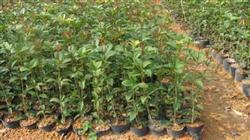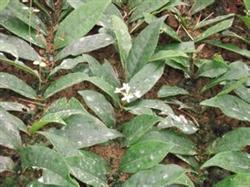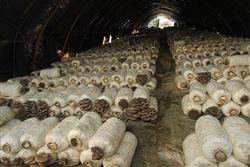Cultivation techniques of Osmanthus fragrans seedlings and key points of Disease and Pest Control

Osmanthus fragrans generally use cuttings to raise seedlings, and single-stem sweet-scented osmanthus usually use sowing to raise seedlings. This is introduced as follows: 1. Osmanthus fragrans bloom from September to October, and the fruit will mature from late March to late April of the following year. When the fruit enters the ripening stage and the pericarp changes from green to purplish black gradually, it can be collected. The collected fruits were piled up for about 3 days. After the peel was softened, the pericarp was soaked and scrubbed, the peel and pulp were removed, and the pure seeds were obtained and slightly dried and moist. Because sweet-scented osmanthus seeds have post-ripening period, it usually takes 8 months for sweet-scented osmanthus seeds to germinate. 2. The method of sowing and raising seedlings is commonly used. A large number of sweet-scented osmanthus seedlings can be obtained by sowing and raising seedlings, which is suitable to be used as street trees. Sowing commonly used wide strip sowing, row spacing of 20 to 25 cm, width of 10 to 12 cm, 20 kg per mu of sowing, per mu of sweet-scented osmanthus seedlings 2.5 to 30,000. Before sowing, put the navel to one side, cover one or two centimeters of fine soil, cover with a thin layer of straw, and spray water until the soil is soaked to prevent soil consolidation and reduce water evaporation. When the seeds germinated and unearthed, uncover the grass in time and put the grass between the rows, which can not only keep the soil moist, but also prevent the growth of weeds. Key points of cultivation and maintenance of sweet-scented osmanthus trees (1) ploughing and weeding. Focus on loosening soil and weeding in a 1m diameter tree plate with the trunk as the center. After irrigation or rainfall, ploughing and loosening the soil is carried out to prevent soil consolidation. (2) watering and drainage. The watering of sweet-scented osmanthus is mainly within one month after the new planting and in the summer of the same year. Newly planted sweet-scented osmanthus must be watered and conditionally sprayed with water on the crown of the plant to maintain a certain amount of air humidity. Osmanthus fragrans is not tolerant to waterlogging, timely drainage or transplanting waterlogged plants, and adding a certain amount of sand planting can promote the growth of new roots. (3) rational fertilization. Fertilization should be based on the principle of frequent application of thin fertilizer, mainly available nitrogen fertilizer, and medium and large seedlings should be fertilized three or four times a year. Organic fertilizer was applied in the tree plate in early spring to promote the growth of spring shoots. Inorganic fertilizer or garbage fertilizer should be applied in the early stage of winter. In the meantime, fertilizers can be applied once or twice according to the growth of sweet-scented osmanthus. For newly transplanted sweet-scented osmanthus, topdressing should not be too early. The base fertilizer of the transplanting pit should be mixed with the soil and then covered with soil. (4) shaping and pruning. ① sprouting: when sprouting, peel off the useless buds in the lower part of the trunk. ② thinning: maintain a certain height under the branches, cut off useless branches, the general height of sweet-scented osmanthus branches after growing up is about 1.5m. ③ truncation: cut off the long top branches to keep the sweet-scented osmanthus at a height of about 3.5m and a crown width of 2.5m to 3m. Sweet-scented osmanthus tree diseases and insect pests control sweet-scented osmanthus brown spot, sweet-scented osmanthus leaf spot and sweet-scented osmanthus anthracnose are common leaf diseases of sweet-scented osmanthus. These diseases can cause early defoliation of sweet-scented osmanthus, weaken plant growth and reduce flower yield and ornamental value of sweet-scented osmanthus. At the initial stage of the onset of sweet-scented osmanthus brown spot, chlorotic small yellow spots appeared on the leaves, which gradually expanded into nearly round spots with a diameter of 2 to 10mm, or irregular spots due to the limitation of leaf veins. The disease spot is yellowish brown to grayish brown with a yellow halo on the periphery of the spot. Brown spot usually occurs from April to October, and old leaves are more susceptible to the disease than young ones. The pathogen overwintered on the diseased fallen leaves with hyphae and produced conidia for primary infection in the following spring. The conidia were transmitted by airflow and raindrops. The pathogen of sweet-scented osmanthus blight mostly invaded from the leaf edge and leaf tip, and occurred at the leaf edge and leaf tip. In the early stage of the disease, light brown dots appeared on the leaves, which gradually expanded into round or irregular plaques, and then expanded into near round or irregular grayish brown spots, with dark brown edges. Blight occurs from July to November and can occur year-round in greenhouses with poor environmental conditions. The pathogen is infected by conidia through wind and water. The environment of high temperature, high humidity and poor ventilation is beneficial to the disease. The disease was more serious in the old leaves and lower leaves of the plant during the weakening of plant growth and after overwintering. Sweet-scented osmanthus anthracnose infects sweet-scented osmanthus leaves. At the initial stage of the disease, small chlorotic spots appeared on the leaves, and gradually enlarged to form round, semicircular or oval spots. The disease spot is light brown to grayish white, with reddish-brown rings on the edge. Under moist conditions, a pink myxospore disk appears on the spot. Anthrax occurs from April to June. The pathogen overwintered in diseased leaves with conidia and was transmitted by wind and rain. First of all, the prevention and control measures should reduce the source of infection. Thoroughly remove the diseased leaves in autumn. Potted sweet-scented osmanthus should remove the diseased leaves in time. Secondly, strengthen the cultivation management. Select fertile and well-drained soil or substrate to plant sweet-scented osmanthus; increase the application of organic fertilizer and potassium fertilizer; planting density should be suitable for ventilation and light transmission, reduce leaf humidity and reduce the occurrence of diseases. Scientific use of chemicals for prevention and control. At the initial stage of the disease, spray 1V 2v 200 times Bordeaux solution, and then spray 50% carbendazim wettable powder 1000 times or 50% benzoate wettable powder 1000 to 1500 times. The serious disease area should be soaked and disinfected with 1000 times potassium permanganate solution when the seedlings came out of the nursery. Pest control: the main pest of family breeding sweet-scented osmanthus is mites, commonly known as red spiders. Once the disease is found, it should be disposed of immediately, and foliar spray can be carried out with mite, aphid and triazoltin. Spray both sides of the blade evenly. Once a week, 2-3 times in a row, can be cured.
- Prev

Rapid asexual Propagation of Osmanthus fragrans
First, the selection of mother plant and branch. The mother should choose the plant with 10-15 years old, strong growth, many branches and low nodes; the branches used for pressing branches are exuberant, disease-free, epidermis is not damaged, bud eyes are full, and branches are about 1 meter long. About 10 days before pressing branches, remove weeds within 1-1.2 meters around the female parent.
- Next

High yield of Coprinus comatus cultivated in wave mode
Select strains to "quasi" August to September feeding sowing, natural temperature is high, fruiting period sometimes appears high temperature above 30℃; after entering October, the temperature will gradually decrease, in order to ensure that high temperature and low temperature period can be normal fruiting, select strains must be both high temperature resistance, but also can take into account the excellent low temperature fruiting.
Related
- Fuxing push coffee new agricultural production and marketing class: lack of small-scale processing plants
- Jujube rice field leisure farm deep ploughing Yilan for five years to create a space for organic food and play
- Nongyu Farm-A trial of organic papaya for brave women with advanced technology
- Four points for attention in the prevention and control of diseases and insect pests of edible fungi
- How to add nutrient solution to Edible Fungi
- Is there any good way to control edible fungus mites?
- Open Inoculation Technology of Edible Fungi
- Is there any clever way to use fertilizer for edible fungus in winter?
- What agents are used to kill the pathogens of edible fungi in the mushroom shed?
- Rapid drying of Edible Fungi

